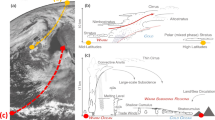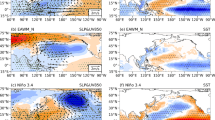Abstract
Parameterizations of normal atmospheric modes (NAMs) and orographic gravity waves (OGWs) are implemented into the mechanistic general circulation model of the middle and upper atmosphere (MUA). Numerical experiments of sudden stratospheric warming (SSW) events are performed for climatological conditions typical for January and February using meteorological reanalysis data from the UK MET Office in the MUA model averaged over the years 1992–2011 with the easterly phase of quasi-biennial oscillation (QBO). The simulation shows that an increase in the OGW amplitudes occurs at altitudes higher than 30 km in the Northern Hemisphere after SSW. The OGW amplitudes have maximums at altitudes of about 50 km over the North American and European mountain systems before and during SSW, as well as over the Himalayas after SSW. At high latitudes of the Northern Hemisphere, significant (up to 50–70%) variations in the amplitudes of stationary planetary waves (SPWs) are observed during and after the SSW. Westward travelling NAMs have local amplitude maximums not only in the Northern Hemisphere, but also in the Southern Hemisphere, where there are waveguides for the propagation of these modes. Calculated variations of SPW and NAM amplitudes correspond to changes in the mean temperature and wind fields, as well as the Eliassen-Palm flux and atmospheric refractive index for the planetary waves, during SSW. Including OGW thermal and dynamical effects leads to an increase in amplitude (by 30–70%) of almost all SPWs before and during SSW and to a decrease (up to 20–100%) after the SSW at middle and high latitudes of the Northern Hemisphere.
Similar content being viewed by others
References
R. M. McInturff, Stratospheric Warmings: Synoptic, Dynamic and General Circulation Aspects, Ed. by M. McInturff (NASA, Washington, D.C., 1978).
M. E. McIntyre, “How well do we understand the dynamics of stratospheric warmings,” J. Meteorol. Soc. Jpn., 60, 37–64 (1982).
R. Quiroz, “The stratospheric evolution of sudden warmings in 1969–74 determined from measured infrared radiation fields,” J. Atmos. Sci. 32, 211–224 (1975). doi 10.1175/1520-0469(1975)032<0211:TSEOSW>2.0.CO;2
K. Labitzke, “Interannual variability of the winter stratosphere in the northern hemisphere,” Mon. Weather Rev., 105, 762–770 (1977). doi 10.1175/1520- 0493(1977)105<0762:IVOTWS>2.0.CO;2
M. Schoeberl, “Stratospheric warmings—observations and theory,” Rev. Geophys. 16, 521–538 (1978). doi 10.1029/RG016i004p00521
M. P. Baldwin, L. J. Gray, and T. J. Dunkerton, “The quasi-biennial oscillation,” Rev. Geophys. 39 (2), 179–229 (2001).
M. P. Baldwin, M. Dameris, and T. G. Shepherd, “How will the stratosphere affect climate change?,” Science 316, 1576–1577 (2007).
L. Sun and W. A. Robinson, “Downward influence of stratospheric final warming events in an idealized model,” Geophys. Res. Lett. 36, L03819 (2009). doi 10.1029/2008GL036624
D. E. Siskind, S. D. Eckermann, J. P. McCormack, L. Coy, K. W. Hoppel, and N. L. Baker, “Case studies of the mesospheric response to recent minor, major and extended stratospheric warmings,” J. Geophys. Res. 115, D00N03 (2010). doi 10.1029/2010JD014114
J. Kurihara, Y. Ogawa, S. Oyama, S. Nozawa, M. Tsutsumi, C. M. Hall, Y. Tomikawa, and R. Fujii, “Links between a stratospheric sudden warming and thermal structures and dynamics in the high-latitude mesosphere, lower thermosphere, and ionosphere,” Geophys. Res. Lett. 37, L13806 (2010). doi 10.1029/ 2010GL043643
H. Liu, E. Doornbos, M. Yamamoto, and S. T. Ram, “Strong thermospheric cooling during the 2009 major stratosphere warming,” Geophys. Res. Lett. 38, L12102 (2011). doi 10.1029/2011GL047898
T. Yuan, B. Thurairajah, C.- Y. She, A. Chandran, R. L. Collins, and D. A. Krueger, “Wind and temperature response of midlatitude mesopause region to the 2009 sudden stratospheric warming,” J. Geophys. Res. 117, D09114 (2012). doi 10.1029/2011JD017142
L. Sun, W. A. Robinson, and G. Chen, “The predictability of stratospheric warming events: More from the troposphere or the stratosphere?,” J. Atmos. Sci. 69 2, 786–783 (2011). doi 10.1175/JAS-D-11-0144.1
J. R. Albers and T. Birner, “Vortex preconditioning due to planetary and gravity waves prior to sudden strato spheric warmings,” J. Atmos. Sci. 71, 4028–4054 (2014). doi 10.1175/JAS-D-14-0026.1
D. G. Andrews, J. R. Holton, and C. B. Leovy, Middle Atmosphere Dynamics (Academic, New York, 1987).
O. Buhler, Waves and Mean Flows (Cambridge University Press, Cambridge, 2009).
J. R. Holton, “The dynamic meteorology of the stratosphere and mesosphere,” Meteorol. Monogr. 15 37, 1–218 (1975).
C. McLandress, T. G. Shepherd, S. Polavarapu, and S. Beagly, “Is missing orographic gravity wave drag near 60°S the cause of the stratospheric zonal wind biases in chemistry–climate models?,” J. Atmos. Sci. 69, 802–818 (2012).
E. E. Gossard and W. H. Hooke, Waves in the Atmosphere (Elsevier, Amsterdam, 1975).
C. McLandress, “The seasonal variation of the propagating diurnal tide in the mesosphere and lower thermosphere. Part I: The role of gravity waves and planetary waves,” J. Atmos. Sci. 59 5, 893–906 (2002).
N. M. Gavrilov, A. I. Pogorel’tsev, and C. Jakobi, “Numerical modeling of the effect of latitude-inhomogeneous gravity waves on the circulation of the middle atmosphere,” Izv., Atmos. Ocean. Phys. 41 1, 9–18 (2005).
D. A. Ortland and M. J. Alexander, “Gravity wave influence on the global structure of the diurnal tide in the mesosphere and lower thermosphere,” J. Geophys. Res. 111, A10S10 (2006). doi 10.1029/2005JA011467
S. Watanabe and S. Miyahara, “Quantification of the gravity wave forcing of the migrating diurnal tide in a gravity wave-resolving general circulation model,” J. Geophys. Res. 114, D07110 (2009). doi 10.1029/2008JD011218
J. R. Holton, “The generation of mesospheric planetary waves by zonally asymmetric gravity wave breaking,” J. Atmos. Sci. 41 23, 3427–3430 (1984).
H. G. Mayr, J. G. Mengel, K. L. Chan, and F. T. Huang, “Middle atmosphere dynamics with gravity wave interactions in the numerical spectral model: Tides and planetary waves,” J. Atmos. Sol.-Terr. Phys. 73, 711–730 (2011).
P. Hoffmann, Ch. Jacobi, and C. Borries, “A possible planetary wave coupling between the stratosphere and ionosphere by gravity wave modulation,” J. Atmos. Sol.-Terr. Phys. 75–76, 71–80 (2012). doi 10.1016/j.jastp.2011.07.008
N. M. Gavrilov, A. V. Koval’, A. I. Pogorel’tsev, and E. N. Savenkova, “Numerical simulation of the response of general circulation of the middle atmosphere to spatial inhomogeneities of orographic waves,” Izv., Atmos. Ocean. Phys. 49 4, 367–374 (2013).
N. M. Gavrilov, A. V. Koval, A. I. Pogoreltsev, and E. N. Savenkova, “Numerical modeling influence of inhomogeneous orographic waves on planetary waves in the middle atmosphere,” Adv. Space Res. 51 11, 2145–2154 (2013).
A. I. Pogoreltsev, A. A. Vlasov, K. Froehlich, and Ch. Jacobi, “Planetary waves in coupling the lower and upper atmosphere,” J. Atmos. Sol.-Terr. Phys. 69, 2083–2101 (2007). doi 10.1016/j.jastp.2007.05.014
M. Inoue, M. Takahashi, and H. Naoe, “Relationship between the stratospheric quasi-biennial oscillation and tropospheric circulation in northern autumn,” J. Geophys. Res. 116, D24115 (2011). doi 10.1029/ 2011JD016040
A. I. Pogoreltsev, E. N. Savenkova, N. N. Pertsev, “Sudden stratospheric warmings: The role of normal atmospheric modes,” Geomagn. Aeron. (Engl. Transl.) 52 3, 357–372 (2014).
A. I. Pogoreltsev, “Simulation of planetary waves and their influence on the zonally averaged circulation in the middle atmosphere,” Earth Planets Space, 51 (7–8), 773–784 (1999).
M. S. Longuet-Higgins, “The eigenfunctions of Laplace’s tidal equation over a sphere,” Philos. Trans. R. Soc. London 262, 511–607 (1968).
A. I. Pogoreltsev, A. Yu. Kanukhina, E. V. Suvorova, and E. N. Savenkova, “Variability of planetary waves as a signature of possible climatic changes,” J. Atmos. Sol.-Terr. Phys. 71, 1529–1539 (2009). doi 10.1016/ j.jastp.2009.05.011
N. M. Gavrilov and A. V. Koval, “Parameterization of mesoscale stationary orographic wave forcing for use in numerical models of atmospheric dynamics,” Izv., Atmos. Ocean. Phys. 49 3, 244–251 (2013).
J. F. Scinocca and N. A. McFarlane, “The parameterization of drag induced by stratified flow over anisotrophic orography,” Q. J. R. Meteorol. Soc. 126 568, 2353–2393 (2000).
Ch. Jacobi, K. Fröhlich, and Y. Portnyagin, “Semiempirical model of middle atmosphere wind from the ground to the lower thermosphere,” Adv. Space Res. 43 2, 239–246 (2009).
I. N. Fedulina, A. I. Pogoreltsev, and G. Vaughan, “Seasonal, interannual and short-term variability of planetary waves in UKMO assimilated fields,” Q. J. R. Meteorol. Soc. 130 602, 2445–2458 (2004).
R. E. Dickinson, “Planetary Rossby waves propagating vertically through weak westerly wave guides,” J. Atmos. Sci. 25, 984–1002 (1968).
T. Matsuno, “Vertical propagation of stationary planetary waves in the winter Northern Hemisphere,” J. Atmos. Sci. 27, 871–883 (1970).
N. M. Gavrilov, A. V. Koval, A. I. Pogoreltsev, and E. N. Savenkova, “Simulating influences of QBO phases and orographic gravity wave forcing on planetary waves in the middle atmosphere,” Earth, Planets Space 67, 86 (2015). doi 10.1186/s40623-015-0259-2
D. J. Karoly and B. J. Hoskins, “Three dimensional propagation of planetary waves,” J. Meteorol. Soc. Jpn. 60, 109–123 (1982).
J. R. Albers, J. P. McCormack, and T. R. Nathan, “Stratospheric ozone and the morphology of the northern hemisphere planetary waveguide,” J. Geophys. Res.: Atmos. 118, 563–576 (2013). doi 10.1029/ 2012JD017937
J. A. Rice, Mathematical Statistics and Data Analysis (Duxbury Press, Pacific Grove, 2006).
Author information
Authors and Affiliations
Corresponding author
Additional information
Original Russian Text © N.M. Gavrilov, A.V. Koval, A.I. Pogoreltsev, E.N. Savenkova, 2017, published in Izvestiya Rossiiskoi Akademii Nauk, Fizika Atmosfery i Okeana, 2017, Vol. 53, No. 6, pp. 674–685.
Rights and permissions
About this article
Cite this article
Gavrilov, N.M., Koval, A.V., Pogoreltsev, A.I. et al. Numerical simulation of wave interactions during sudden stratospheric warming. Izv. Atmos. Ocean. Phys. 53, 592–602 (2017). https://doi.org/10.1134/S0001433817060044
Received:
Accepted:
Published:
Issue Date:
DOI: https://doi.org/10.1134/S0001433817060044




